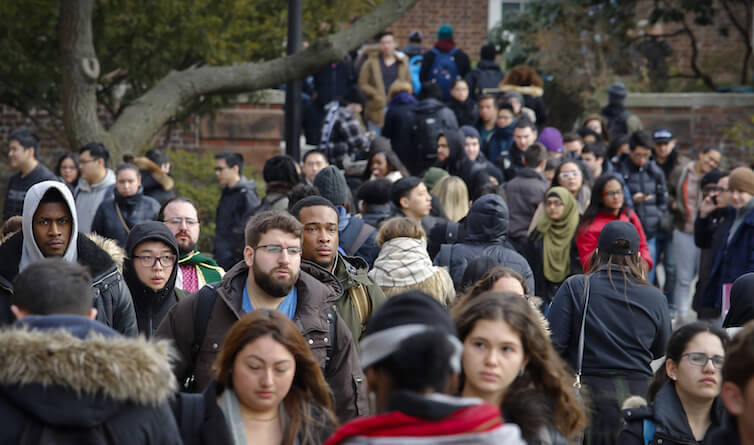
Investing in early childhood education is a research-backed, cost-effective strategy for boosting long-term U.S. economic growth. For instance, economics Nobel Laureate James Heckman’s analyses of two comprehensive early childhood programs suggest a 7 percent to 13 percent annual return on investment in improved school and labor-market outcomes, as well as reduced public costs in remedial education, health, and criminal justice spending.
While the imperfect consensus is that early childhood education is a solid investment, we know far less about how best to ensure efficient spending of public dollars. The readiness gap between lower- and higher-income children shows up on the very first day of kindergarten, suggesting a persistent need for effective investment in low-income children. Indeed, this gap was part of the impetus behind the federally funded and means-tested Head Start program, which began in 1965 as part of President Lyndon Johnson’s War on Poverty and today serves about 1 million poor 3- and 4-year-olds annually.
Yet the federal Head Start program serves fewer than half of all eligible children due to chronic underfunding of the program. Moreover, millions more working families with incomes above the federal poverty level ($20,090 for a family of three in 2015) face severe economic pressure from high and rising childcare costs. In the absence of federal action, state experimentation with public pre-Kindergarten has blossomed over the past decade.
Forty-two states plus the District of Columbia offer some version of publicly funded pre-K, but the allocation of funds varies dramatically across programs. State programs can be roughly divided into three categories. One is universal, low-standard programs, which provide universal access to age-eligible children regardless of income but with few and/or low standards—Florida’s pre-K program exemplifies this approach. Another is targeted programs, which are means-tested or targeted to address other risk factors, with stringent state standards—Tennessee is a prime example of this approach. And the third category is universal, high-standard programs, which provide universal access and have stringent state standards for quality. Georgia and Oklahoma have such pre-K programs in place.
Which type of program best achieves the goal of boosting achievement for low-income children?
New research from Dartmouth University economist Elizabeth Cascio provides compelling evidence for the efficacy of high-quality universal pre-K as compared to high-quality programs targeted at disadvantaged children. Using a large, nationally representative dataset that allows her to track outcomes for a cohort of children born in 2001, Cascio isolates the causal impact of pre-K attendance on a range of academic and social-emotional outcomes for low- and high-income children across different types of programs. In general, she concludes that “state-funded pre-K appears to be more effective for low-income children when programs are universal rather than targeted.”
Specifically, Cascio’s new research demonstrates that universal state-funded pre-K programs generate statistically significant and substantial positive improvements in early reading scores for low-income 4-year-olds. State-funded programs targeted to disadvantaged children do not. The same findings hold for improvements in early math scores and noncognitive social-emotional skills such as engagement and negativity, though the findings are less definitive on these two metrics.
Cascio also finds that universal pre-K boosts the performance of low-income children more than it increases the performance of higher-income students, thereby playing a significant role in closing the income-based achievement gap in kindergarten school readiness. Indeed, her estimates suggest that universal pre-K attendance can more than close the income-based test score gaps that exist prior to pre-K entry.
The differences between universal and targeted programs cannot be explained away by program requirements or by the demographics of the children and their families. Nor can they be explained away by the alternative preschool programming available to parents. Together, Cascio’s findings suggest that universal pre-K programs offer relatively high-quality learning environments as compared to targeted programs. Importantly, this research suggests that the quality of universal and targeted pre-K programs differ in important ways that are not reflected in typical measures of school or program quality or state standards.
So why do universal pre-K programs do a better job serving low-income students than programs specifically targeting poor kids? Universal programs may be of higher quality, even if they have the same formal quality standards as targeted programs. Peer effects also may explain much of this quality differential. Lower-income children may benefit from direct interaction with higher-income peers. If higher-income children enter pre-K more prepared, as suggested by the income achievement gaps of incoming pre-K students in Cascio’s data, then universal programs may attract and retain better teachers—for instance, teachers with warmer, more engaged, more creative, and more positive interactions with students.
In short, the presence of higher-income students in the classroom may change the expectations of what all children should learn, which can accelerate learnings gains for all students. Teachers and programs may be under more parental pressure to perform, especially if the engaged parent body includes higher-income, highly educated parents. They may also have access to a range of informal resources, including parental human capital.
While Cascio’s research provides some suggestive findings regarding the mechanisms through which universal pre-K programs are able to deliver for disadvantaged kids, more research remains to be done in this space. What we do know is that universal programs simply reach more kids, including many low-income students who are not quite poor enough for means-tested programs and thus would otherwise lack a quality preschool experience. In 2013, just 54.9 percent of all 3- and 4-year-olds were enrolled in any pre-primary school program, suggesting considerable room to increase preschool attendance. Cascio’s evidence suggests that low-income kids are better served by universal programs. The arithmetic seems to be adding up in favor of high-quality universal pre-K.


